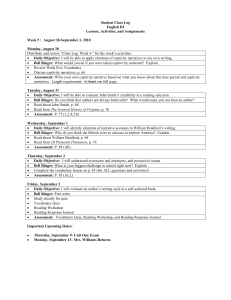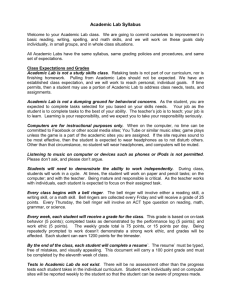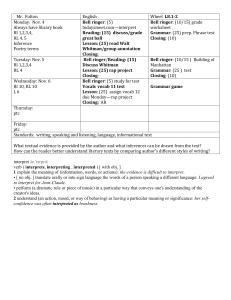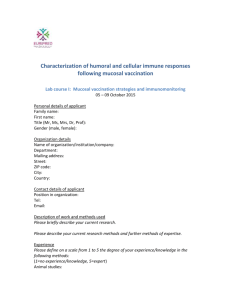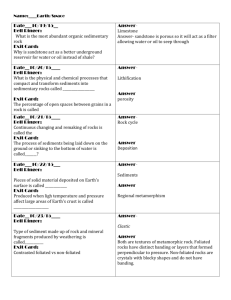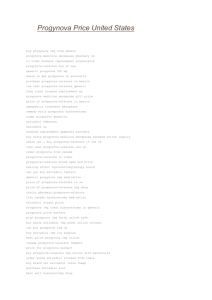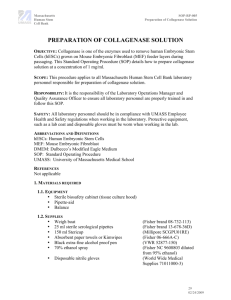SUPPLEMENTARY METHODS Mice C57bl/6 mice were obtained
advertisement
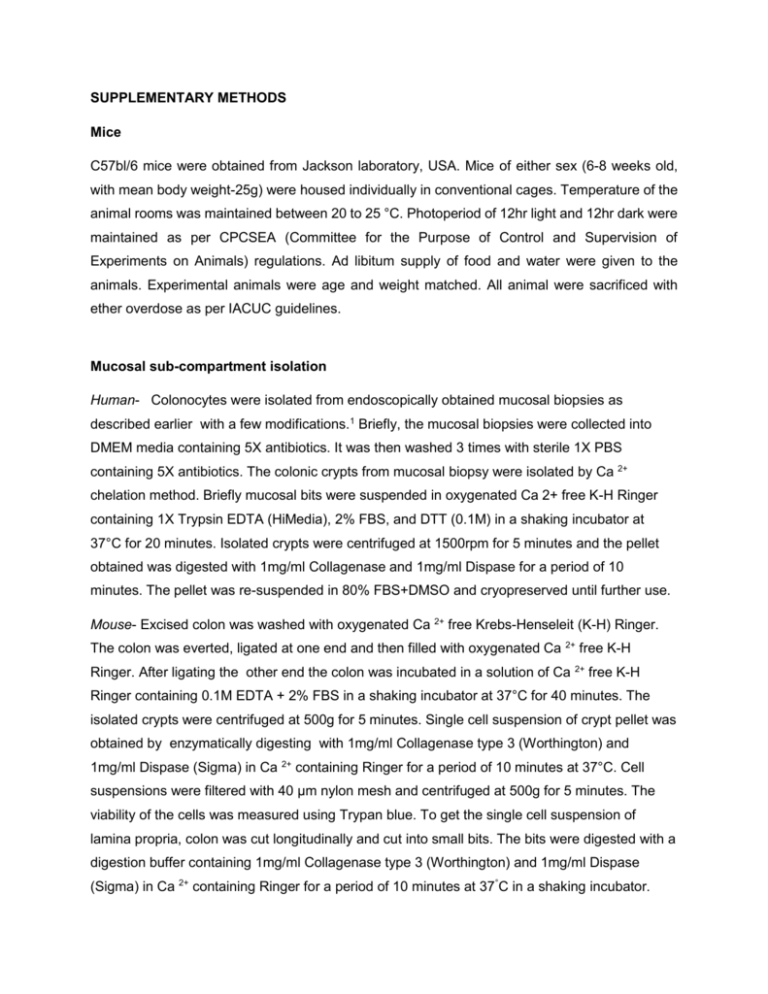
SUPPLEMENTARY METHODS Mice C57bl/6 mice were obtained from Jackson laboratory, USA. Mice of either sex (6-8 weeks old, with mean body weight-25g) were housed individually in conventional cages. Temperature of the animal rooms was maintained between 20 to 25 °C. Photoperiod of 12hr light and 12hr dark were maintained as per CPCSEA (Committee for the Purpose of Control and Supervision of Experiments on Animals) regulations. Ad libitum supply of food and water were given to the animals. Experimental animals were age and weight matched. All animal were sacrificed with ether overdose as per IACUC guidelines. Mucosal sub-compartment isolation Human- Colonocytes were isolated from endoscopically obtained mucosal biopsies as described earlier with a few modifications.1 Briefly, the mucosal biopsies were collected into DMEM media containing 5X antibiotics. It was then washed 3 times with sterile 1X PBS containing 5X antibiotics. The colonic crypts from mucosal biopsy were isolated by Ca 2+ chelation method. Briefly mucosal bits were suspended in oxygenated Ca 2+ free K-H Ringer containing 1X Trypsin EDTA (HiMedia), 2% FBS, and DTT (0.1M) in a shaking incubator at 37°C for 20 minutes. Isolated crypts were centrifuged at 1500rpm for 5 minutes and the pellet obtained was digested with 1mg/ml Collagenase and 1mg/ml Dispase for a period of 10 minutes. The pellet was re-suspended in 80% FBS+DMSO and cryopreserved until further use. Mouse- Excised colon was washed with oxygenated Ca 2+ free Krebs-Henseleit (K-H) Ringer. The colon was everted, ligated at one end and then filled with oxygenated Ca 2+ free K-H Ringer. After ligating the other end the colon was incubated in a solution of Ca 2+ free K-H Ringer containing 0.1M EDTA + 2% FBS in a shaking incubator at 37°C for 40 minutes. The isolated crypts were centrifuged at 500g for 5 minutes. Single cell suspension of crypt pellet was obtained by enzymatically digesting with 1mg/ml Collagenase type 3 (Worthington) and 1mg/ml Dispase (Sigma) in Ca 2+ containing Ringer for a period of 10 minutes at 37°C. Cell suspensions were filtered with 40 μm nylon mesh and centrifuged at 500g for 5 minutes. The viability of the cells was measured using Trypan blue. To get the single cell suspension of lamina propria, colon was cut longitudinally and cut into small bits. The bits were digested with a digestion buffer containing 1mg/ml Collagenase type 3 (Worthington) and 1mg/ml Dispase (Sigma) in Ca 2+ containing Ringer for a period of 10 minutes at 37°C in a shaking incubator. The isolated cells were pelleted at 500g for 5 minutes. The cells were then pooled with the epithelial cells for further analysis. Immunoprecipitation Total cellular protein was extracted from colonocytes and lysed using a lysis buffer (150 mM NaCl, 5 mM EDTA, 10 mM Tris HCl pH 7.4 and 1% Triton X 100). 250µg of whole cell extracts were pre-cleared by incubating with Protein A/G agarose beads and 1 µg of rat IgG monoclonal antibody for 1 hour at 4°C.The pre-cleared whole cell extract was incubated with primary antibody (CD 24 Rat monoclonal IgG2b) for 1 hour at 4 °C and finally with protein A/G agarose beads at 4 °C overnight .The immune complexes were washed with RIPA buffer, boiled with SDS protein dissociation buffer for 3 minutes and then resolved on 12.5% SDS PAGE. Mass Spectrometry The protein bands resolved on the 12.5% SDS PAGE gel were subjected to in-gel digestion with reduction and alkylation.2 The digested peptides were then re-constituted in 15 μL of 2% Acetonitrile with 0.1% formic acid. 1 μL of the same was injected on to the column and subjected to 70 minute RPLC gradient followed by acquisition of the data on LTQ-Orbitrap-MS. The identity of the target proteins were determined using multiple search engines including MASCOT, Swiss-Prot, TrEMBL and NCBI. 1 2 Seidelin JB, Horn T, Nielsen OH. Simple and efficient method for isolation and cultivation of endoscopically obtained human colonocytes. Am J Physiol Gastrointest Liver Physiol 2003;285:G1122-8. Shevchenko A, Tomas H, Havlis J, et al. In-gel digestion for mass spectrometric characterization of proteins and proteomes. Nat Protoc 2006;1:2856-60.

